 Baking and other October News
Baking and other October News
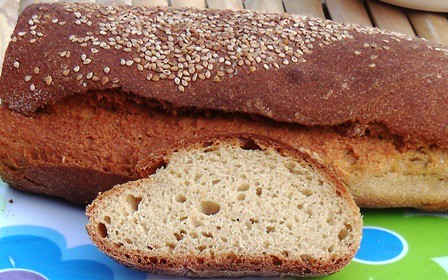

The teaching in Leeds did not work out as I found myself very unsettled and unhappy in a place I did not want to be staying instead of being at home with Alison. There is always opportunity for me to work in Leeds again, but I do not want to be tied to regular delivery of FE baking courses there. I left at half term, and went on holiday to Sicily having already bagged an interview at Gateshead College for an Associate Lecturer post; that’s tomorrow!
Regarding baking, I have made the following breads at home recently:
1. Ciabatta
Wheat Levain built from stock wheat levain; no refreshment details available
Material/Stage | Formula [% of flour] | Recipe [grams] |
1. Wheat Levain | | |
Special CC Flour | 34 | 540 |
Water | 20.4 | 324 |
TOTAL | 54.4 | 864 |
| | |
2. Soaker | | |
Tumminia Flour | 18.9 | 300 |
Water | 47.2 | 750 |
TOTAL | 66.1 | 1050 |
| | |
3a. Final Dough - Bassinage | | |
Levain | 54.4 | 864 |
Soaker | 66.1 | 1050 |
Gilchesters Pizza Flour | 47.1 | 749 |
Salt | 1.76 | 28 |
3b. Water | 12.6 | 200 |
TOTAL | 181.96 | 2891 |
Overall % pre-fermented flour | 34 | - |
Overall % hydration | 80 | - |
Method:
- Build the leaven and set up the soaker in advance
- For the final dough combine the leaven and soaker with flour and salt for a., then mix the “bassinage” stage to develop the dough. Let the down with water as in b.
- Ferment in bulk for 3 hours with “S&F” every 50 minutes. Scale and divide as required. I made 3 trays of Foccaccia flavoured with Roasted Onions and Butternut Squash with Rosemary, as well as 3 loaves of Ciabatta.
- Shape the dough, then final proof for 3 hours. Bake in the wood-fired oven.
- Cool on wires.

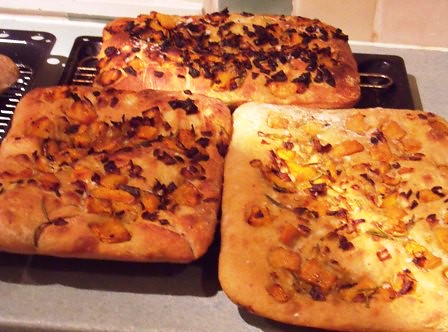
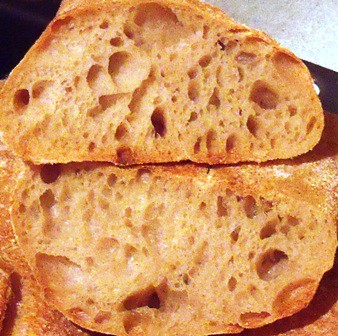
2. Pain Siègle de Thezac.
Sour built from stock Rye Sour; no refreshment details available
Material/Stage | Formula [% of flour] | Recipe [grams] |
1. Rye Sour | | |
Bacheldre Dark Rye | 18 | 360 |
Water | 30 | 600 |
TOTAL | 48 | 960 |
| | |
2. Soaker | | |
Tumminia Flour | 10 | 200 |
Water | 38 | 760 |
TOTAL | 48 | 960 |
| | |
3. Final Dough | | |
Sourdough | 48 | 960 |
Soaker | 48 | 960 |
Special CC Flour/Marriages | 72 | 1440 |
Salt | 1.8 | 36 |
TOTAL | 169.8 | 3396 |
Overall % pre-fermented flour | 18 | - |
Overall % hydration | 68 | - |
Method:
- Build the sourdough and set up the soaker in advance
- Combine all the ingredients with soaker and sour for the final dough and mix to develop.
- Bulk proof time is 3¼ hours, with “S&F” every hour.
- Scale, divide and mould round. I made 3 loaves scaled at 650g and one large with the remaining dough at just less than 1450g
- Final proof for 3 hours in prepared Bannetons
- Tip out each loaf and score the top with an “S”, and bake in the wood-fired oven
- Cool on wires


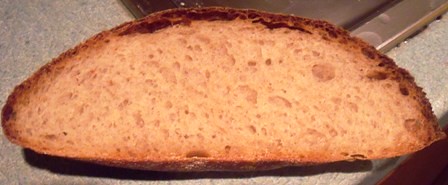
3. Pane Nero di Castelvetrano with Almost-All-Sicilian Flour
Leaven Refreshment:
1. Monday 10:00 Wheat Levain Stock 20g [flour 12.5, water 7.5], “ODDO” Semola Rimacinato 50g, Water 50g.
2. Monday 15:30 Refreshment 1 above 120g [flour 62.5, water 57.5], “ODDO” Semola Rimacinato 137.5g, Water 62.5g
3. Monday 22:30 Refreshment 2 above 320g [flour 200, water 120], “ODDO” Semola Rimacinato 150g, Water 90g TOTAL 560g, as below, used at 06:00 Tuesday. Soaker: set up at 22:30 on Monday with refreshment 3.
Material/Stage | Formula [% of flour] | Recipe [grams] |
1. Wheat Levain | | |
“ODDO” Rimacinata | 25 | 350 |
Water | 15 | 210 |
TOTAL | 40 | 560 |
| | |
2. Soaker | | |
Tumminia Flour | 26 | 364 |
Gilchesters Organic Coarse Semolina | 3 | 42 |
Water | 35 | 490 |
Salt | 1.79 | 25 |
TOTAL | 64 | 896 |
| | |
3. Final Dough | | |
Levain | 40 | 560 |
Soaker | 64 | 896 |
“ODDO” Rimacinata | 46 | 644 |
Water | 18 | 252 |
TOTAL | 169.79 | 2377 |
Overall % pre-fermented flour | 25 | - |
Overall % hydration | 68 | - |
Method:
- Set up levain and soaker [see above timetable]
- Combine leaven and soaker with remaining flour and water and develop the dough, mixing by hand.
- Bulk proof for 3 hours with 1 “S&F” after 1½ hours.
- Scale and divide as 1 x 700g and 1 larger loaf of just over 1.5kg. Mould round.
- Final proof for 3 hours in prepared Bannetons.
- Bake in a pre-heated and hot electric oven using a baking stone and steam. I hadn't the time to chop wood for the brick oven today.
- Cool on wires.
I made the Ciabattas, Foccaccias and Pain de Siègles before we went away on holiday. A colleague in the village was looking after Shuffles [our cat] for a few days, and she had arranged a “Coffee Morning” on the Saturday to raise money to pay for fitting our new Christmas Lights in the village. Most of the breads were my contribution to that event. The bits leftover were for Beverley, my Sister-in-Law and my Niece, Eve, to tuck into when they stayed in our cottage the first weekend. We have enjoyed the last of the big Pain de Siègle loaf on our return from Sicily.
During the holiday, I quickly found a supply of Pane Nero di Castelvetrano, and took photographs to show what the modern day traditional and local version now looks like. The label is very revealing. “L’Antico Forno” means “The Old Bakery”, and it was situated in a smaller town just outside Castelvetrano. The ingredients are listed as Farina di Grano Duro, Aqua, Sale, Lievito. 30% of the flour is from the “Tumminia” durum. I do not have good enough grasp of the Italian language to know whether or not the loaf is made using Baker’s yeast only, or if an element of, or even all, natural leaven is used. From a flavour point of view, I would be inclined to think that Baker’s yeast was the chosen leavener.
However, the rest of the label gives more information to consider. The price of the bread was €3.00 per kilo, with each of the 3 loaves we bought being half kilo loaves. The date of manufacture is shown, and recommended consumption within 5 days. My two main comments: the keeping qualities were superb, and 5 days was a perfectly reasonable shelf life. So I really do wonder about the source of leavening! And, the taste of the bread had such a distinct sweetness to it, which Nico advised of when I first got hold of the Tumminia flour.
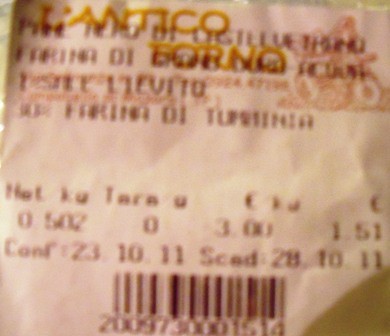

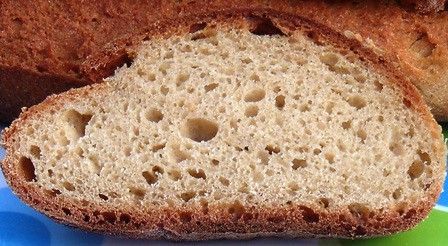

The day we went to Castelvetrano was a shocker; it rained heavily all day, so we were not tempted in any way to stop and seek out Molina del Ponti [see: http://www.molinidelponte.it/], the recommended milling source for a further supply of Tumminia. I did, however, locate some Durum flour in a local supermarket which had been grown in Sicily and milled in nearby Valderice. This is the link to the miller’s website: http://translate.google.co.uk/translate?hl=en&sl=it&u=http://www.molinooddo.it/prodotti.html&ei=sgiwTq-UL86-8gP88eW8AQ&sa=X&oi=translate&ct=result&resnum=1&ved=0CCAQ7gEwAA&prev=/search%3Fq%3DODDO%2Bgrano%26hl%3Den%26sa%3DX%26tbas%3D0%26biw%3D1132%26bih%3D448%26prmd%3Dimvns
I bought a 1kg bag of “Rimacinata” to use to make one more batch of Pane Nero di Castelvetrano, and I also bought a bag of the traditional Cous Cous which is very common in the north west of Sicily demonstrating an Arabic and African tradition.
My final formula for the loaves are given above, and plenty of photos to illustrate the whole post.




The sweet taste is there, and, a huge step forward here; Alison is raving about the crust on this bread! This is a new and very welcome event.
Happy Baking to you all!
Andy